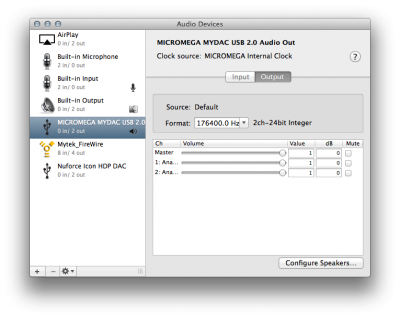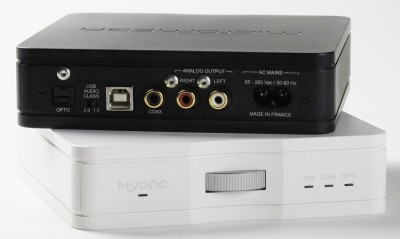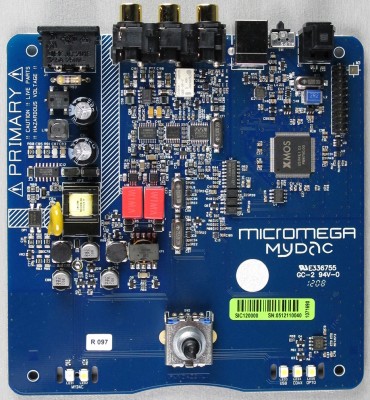Micromega MyDAC — Quelle Joyeaux
The diminutive MyDAC is Micromega’s first foray into the standalone DAC market, and their care and considered design choices have produced an exemplary product. MyDAC is 5.5″ square and 1.5″ tall; a dwarf Mac mini, if you will. The finish is either black or white, and the front fascia is equally minimalist. A small red/white LED indicates standby/power, an aluminum thumb wheel on the front selects the input while white LEDs mark your selection.
Although Micromega states that MyDAC has “…extremely low power consumption in standby mode ( <500 mW) as well as during operation (< 2.5W),” I measured 2.6 Watts or 0.21 Amps while operating the unit. Despite the miniscule discrepancy, this is nonetheless a tiny amount of power costing pennies a month to operate.
The MyDAC has USB and S/PDIF (coax and optical) digital audio inputs. The USB interface is Class 2–compliant, making it plug and play on recent versions of Mac OS. For Windows users, the manufacturer provides a driver. More on USB support in just a moment…
All inputs accept 44.1 and 48 kHz, and their 2x and 4x multiples. I tested all three inputs – they work as advertised. Since Type II optical is the lowest common denominator of digital transmission standards‡ (gets the job done but sounds awful) and, since the designer pegged USB as his fave, I stuck with USB rather than the Type II unbalanced on RCA as my spigot of choice for evaluation. Regarding input choices, Daniel Schar, R&D Manager at Boissy Saint Léger–based Audis SARL and the principal designer of MyDAC, mentioned that, “Of course, the USB input offers the best performance because of (its) asynchronous mode…in this case the master clock is local to the D/A converter IC and controls (determines, actually – OMas) the jitter of the incoming signal. In the case of the two S/PDIF inputs, opto and coax, the master clock is recovered by the Digital Input Receiver and cannot have as low jitter as the USB master clock.” Canned ham, anyone?
As with many other appreciated design aspects of MyDAC, the back panel has a fairly rare switch…
Just to the left of the USB input port is a “USB AUDIO CLASS” switch. Redmond may have left audiophiles in the lurch, but Micromega hasn’t. This affords Windows users driverless Plug & Play for up to 96 k in USB 1.0 mode. Mac OS users have only to kick it into 2.0 mode and get 4x support up to 192 k.
Unlike many DAC designs, there is no upsampling option. Mastering engineers notwithstanding who need to “fix” nasty sounding material through an esoteric analog chain†, this generally a good thing. I want my bits to be as unmolested as possible. The designer of MyDAC is in concordance on this issue. Schar notes that, “We…think that native files are always more truthful to the original message than…digitally manipulated content which always brings artifacts.” Amen, bro.
“Budget” DACs usually have a crystal referenced, phase-locked-loop controlled clock. One hideously expensive DAC I know touts its ovenized crystal as if it were an exotic thing. The MyDAC takes another path, with a more modern clock which, I’m guessing, contributes to its smooth sound. I asked Schar about his choices that went into the clocking arrangement. “In my opinion, there are two major issues in digital reproduction, one being timing and the second one being noise. In MyDAC we try to address both issues, the first one with an elaborate master clock and the second one with the power supplies,” Schar said. “There are actually 2 master clocks, one for the 44.1 kHz multiples and one for the 48 kHz multiples. Both clocks are discrete designs with their own very low noise power supply.” This applies to the asynchronous USB input as well as the AES inputs. For the two IEC digital audio ins, unbalanced on an RCA and POF on an F05, the receiver circuit is a Wolfson 8804. The Wolfson part has the “lowest receiver jitter available,” according to Schar, “with a typical 50 pSec. jitter figure, thanks to the use of an internal DDS avoiding the use of an analog PLL with an external filter.” DDS or Direct Digital Synthesis frequency references were popularized in “agile” radio transceivers first used by the military.
MyDAC has an integrated power supply; no dread wall warts here, kids. In keeping with the minimum noise brief, a cheeseball external supply couldn’t meet the designer’s stringent audio requirements. “MyDAC is equipped with 2 different power supplies: The first one is a flyback type used for all circuitry not audio related. For the audio part a specific ultra low noise, pure sinusoidal high frequency power supply with no electrolytic capacitors… in the smoothing section nor in the audio path. The flyback is optimized for noise and low interference while the audio supply is optimized for noise and dynamic behavior.” For the flyback design, I asked if it’s running at a high or low frequency…“Actually the flyback converter is a QR (quasi–resonant) type where the frequency varies with the load. This frequency runs between 60 kHz and 120 kHz depending upon the load. This has been chosen to be way above the audio band and to create minimal intermodulation (IM) with the audio signal.” IM distortion is particularly distasteful to hear.
This is not a “me too” product, but yields a high level of performance at an entry level price. I wanted to know what cost cutting measures were employed to bring it in at its price point. Schar told me that every product is, in some ways, a compromise but the basic function of a product should be the first design priority. “Many customers are inclined to go for heavy units with a lot of metal,” the bling factor exerting a strong audiophilia attraction for both buyer and seller. “We believe than an audio product should first of all offer excellent audio reproduction performance before anything else. On another end the non–magnetic enclosure of (all the My product line) helps controlling the high frequency behavior on the ‘board level,’ with extremely careful layout. Finally, by using the right part at the right place we save redundancy (and) saving cost where it is not necessary.”
Since he brought up aural impressions, you may be wondering how does MyDAC sound? Basically, like a scaled back version of far more costly pieces. It has a lovely, distortion–free presentation, with a comparatively wide and deep soundstage and a sense of generous bandwidth. When pitted against Ye Olde Bougette Standby, my crusty NuForce Icon HDP, the MyDAC offers an extended high end and far more sparkly transients. Listening to MyDAC after the HDP, it was as though I’d popped the grill cloth off my speakers. The Micromega was also smoother, far less edgy than the older, simpler tech of the NuForce; my guess would be less jitter along with less overall noise and distortion. On the low end, the NuForce rendered bass drums pillowy, a tad flabby, while MyDAC delivered tight, punchy kick and fulsome bass. Mind you, the HDP cost about the same back in the day as MyDAC, and was quite respectable in its time for a budget piece.
I was a bit surprised by the MyDAC’s low end, as I also compared it to another unit I have in house, the mastering version of Mytek’s Stereo192-DSD. While the Micromega exhibited a very satisfying booty, it also did a tad better than the Mytek, which is giving me a lean lower octave at present…I do need to burn it in more. In other respects, specifically features and extended high end, the Mytek trounced the little guy, as well it should. When compared to the Mytek, the slight absent detail and air was apparent. Granted, Mytek’s product cost four times more that the MyDAC, but breath & string noise, brushes and other high frequency–rich aspects of my files had a faintly veiled aspect through MyDAC.
Given the price, MyDAC is not and cannot be the end–all, be–all of DACdom. Still, its welcome ability to extract the essence of a file is a beautiful thing. Also, its support for 176.4 and 192 k should not be discounted, as a goodly amount of wonderful content is now available at those sampling rates. In brief, MyDAC is a strikingly tremendous performer. It’s vanishingly low distortion, robust bottom and broad, lively presentation marks it as a top contender in it’s price bracket and an excellent choice for those exploring file–based playback…I cannot wait to hear what Micromega is capable of without a price constraint!
Music in heavy rotation during this review:
- Antal Doráti: Detroit Symphony Orchestra — Copland: Fanfare; Dance Symphony; 4 Dance Episodes From Rodeo; Appalachian Spring, Etc. (1991) [perkier than a cup’a joe]
- Corey TuT — Chasing Down the Bedlam (2013) [anthemic power pop]
- Daft Punk — Random Access Memories (2013) [ear worms in high rez]
- Kevin Coelho — Turn It Up (2013) [the legacy of Booker T. as seen though a jazz–infused gravity lens]
- Original Broadway Cast — South Pacific (1949/1998) [Richard & Oscar rockin’ the house]
- Outkast — Speakerboxxx/The Love Below (2003) [finessed, often tongue–in–cheek hiphop]
- Queens of the Stone Age — Era Vulgaris (2007) [can dirt be this good?]
- Robert Glasper Experiment — Black Radio (2012) [jazz takes a left turn, collides w/urban roots]
- Trombone Shorty — Sing Me Back Home: The New Orleans Social Club (2006) [fresh, funky Dixieland]
Additional gear used for this review
- Sources: Amarra Symphony w/iRC, Fidelia w/FHX, iTunes
- Cans: Audeze LCD-3, Etymotic ER•4PT, Klipsch Image X10i, Audiofly AF45, Skullcandy Titan
- Speakers: Bowers & Wilkins 685, IsoAcoustics ISOL8R155, Sanus Foundations Steel
- Amplification: Bryston 3B, Rocness BA-3 Pre, SPL Phonitor (factory mod’d)
- Cabling: Soundstring GEN II Beta 2-22S, Wireworld Starlight 7 (USB), Perfect Vision RG-6, Cardas HPI-A
- Power: Soundstring GEN II Digimax-18
† — A Word on Upsampling:
Upsampling, by its very nature, fundamentally changes the incoming or source bitstream through interpolation and filtering. The result is new data that some would say is “better” than the source. For one thing, it ain’t the source anymore and that, to me, is a mighty big argument against using it. If I were charged with mastering the track, and my job was to “sweeten” it up, I might use upsampling or any other tool in my kit to make it more subjectively pleasing. That said, I’m not the mastering engineer so I usually like to hear my music bit–perfect.
‡ — A Word on IEC Type II Optical:
You’ll find that little F05 connector on the back of many CE (Consumer Electronics) and MI (“Musical Instrument” a.k.a. semi–pro) audio products. Those 5 mm fiber connectors are typically used with POF or Plastic Optical Fiber. POF is a poor substitute for glass fibre, and F05 connectors are a poor substitute for ST connectors found on high end hifi gear. When taken together, the low cost combination of plastic connector and plastic fiber results in high losses at the terminations, each connector end, and through the fiber itself. The result is a relatively poor signal–to–noise ratio, which in turn results in a degraded “eye pattern” and reduced tolerances at the AES (digital audio signal) receiver. Like the proverbial domino effect, the reduced tolerance translates into higher sensitivity to jitter, or timebase instability. Any refraction in the fiber, rather than pure reflection which is the ideal, creates the equivalent of multipath, smearing arrival times and making matters even worse.







I liked it so much, I ended up buying the review sample!
– OMas
Nice review. I own it too. I used to have asus zonar essence stx soundcard which I broke while upgrading the op amps. When I used the mydac with my adam f7, i noticed the fuller, thicker sound right away. But I’ll probably @ some point of time in future will upgrade to a more expensive dac for the more richer, fuller tone with more sustain and air. But for the time being I’m happy with this.